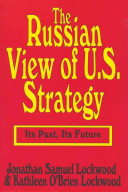
The Russian View of U.S. Strategy its past, its future
By - Lockwood, Jonathan Samuel, , Lockwood, Kathleen O'Brien
Floor
-
Floor 1
Published
-
Transaction Publishers, New Brunswick, ©1993
ISBN 10 - 1560000317
ISBN 13 - 9781560000310
Book Status
-
1 Qnty Available with us.
Subject
-
Military doctrine Soviet Union History
Shelf No
-
18
Call Number
-
355.0217 LOC
Physical Description
-
233 pages ; 24 cm
Notes
-
Includes index